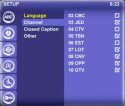Modular, skinable app stack for digital TVs, STBs supports Linux
May 13, 2004 — by LinuxDevices Staff — from the LinuxDevices Archive — views Espial has launched a “comprehensive,” modular, skinable software stack for digital TVs (DTVs) and set-top boxes (STBs) with a memory footprint as low as 100KB, and “consumer-grade” performance on a 50MHz processor.
Espial has launched a “comprehensive,” modular, skinable software stack for digital TVs (DTVs) and set-top boxes (STBs) with a memory footprint as low as 100KB, and “consumer-grade” performance on a 50MHz processor.
According to Espial, Evo is available now, and is supplied as C program code that can be built for systems based on Linux or “other embedded operating systems.” Supported processor architectures include MIPS, PowerPC, ST Micro, and x86.
Evo supports markup-language based customization, enabling manufacturers or providers to brand their devices or services with few changes to underlying code.
Evo's modular components include:
- Evo Display — a skin-able on-screen display with a scalable menu system, configurable remote control-activated visual display, and 708-B configuration for DTV tuners

Evo's Display - Evo Guide — a skin-able Electronic Program Guide application with basic now-and-next as well as grid-based, multi-day information; can display PSIP and DVB-SI data through the skin-able user interface

Evo's EPG - Evo Viewer — an extended HTML and CableCard Content Viewer that supports the CableLabs requirement in the US for CableCard content with extended tag and transition support for other 'managed content' browsing
The suite does not include a browser. Espial separately offers an Escape browser, which requires a Java virtual machine (VM). An optional “Portability Engine” is also available which includes a VM that runs on Linux, along with various fonts and APIs optimized for video applications.
“The Espial Evo solution bundles in the most important applications (Display and Guide) with an easy-to-customize user interface,” said Simon Roh, managing director of Techsan UK. “We were intrigued to see cutting edge UI transitions and techniques that are effective on even the simplest TV design.”
“Consumer electronics manufacturers have been looking for the ability to easily customize the look and feel of their consumer electronics designs as a way to stand out from the competition,” said ABI analyst Vamsi Sistla. “From a technology standpoint, application layer software – along with latest interfaces, micro display technologies, and high computing power, is proving to be another valuable differentiator for consumer electronics OEMs.”
This article was originally published on LinuxDevices.com and has been donated to the open source community by QuinStreet Inc. Please visit LinuxToday.com for up-to-date news and articles about Linux and open source.